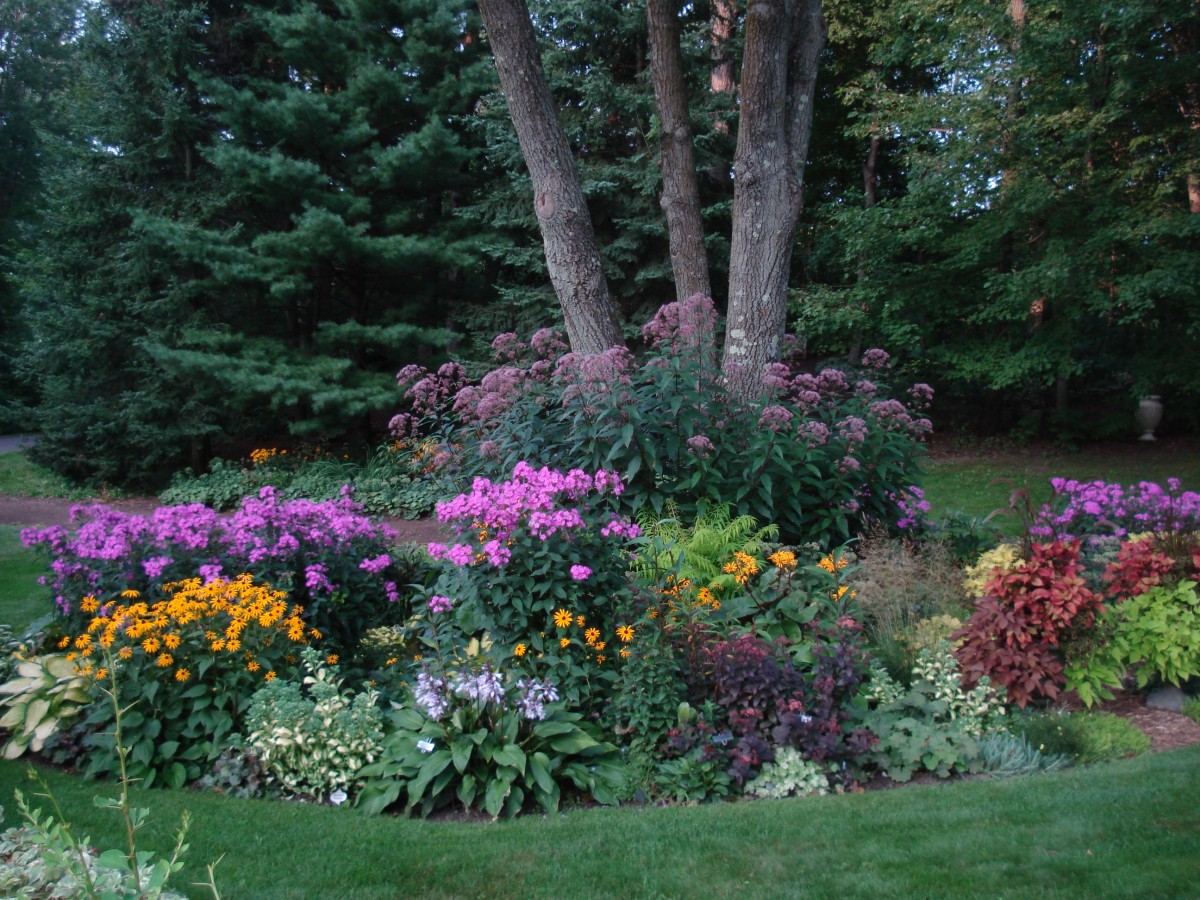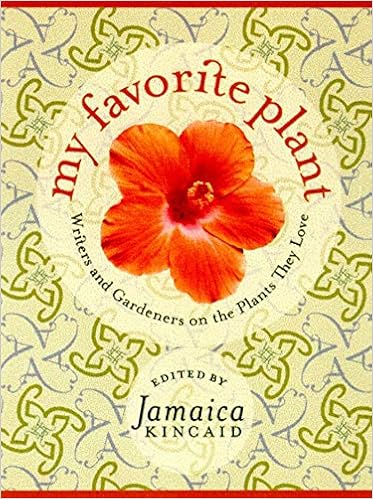Gardening is really an extended form of reading, of history and philosophy. The garden itself has become like writing a book. I walk around and walk around. Apparently people often see me standing there and they wave to me and I don’t see them because I am reading the landscape.
Jamaica Kincaid
My love of nature is great, though my show of it is meager. The shadow of expectation, I suspect–my mother is an avid gardener with a number of bird feeders for the cardinals, orioles, woodpeckers, chickadees, and various other breeds flittering among Wisconsin’s trees. Those feeders are always stationed outside a window near the kitchen table, where no matter the season, my mother can enjoy her meal with the company of the nature she tends so lovingly.

Meanwhile, the bushes around my home have withered and died. Hostas–I think they’re hostas–have grown so wild and tangled in the back that I wouldn’t be surprised if the Rats of NIMH had made a second home beneath their roots. Our single shade tree’s losing its bark and many of its branches refuse to bud. Even the small potted cactus my mother had given me years ago for some sort of greenery in the house has long since died.
Years ago, I would simply blame all this botanical death on motherhood. I couldn’t focus on a garden with Biff and Bash running rampant. I couldn’t afford to garden when the basement flooded and we had to replace things like the furnace and air conditioner. I couldn’t afford to garden when the kids were in school because I was only working part-time and money’s needed elsewhere. I can’t afford to garden because I’m working full-time and time is always needed on the computer, not outside.
Yet my mother worked full-time all my life, and her gardens surrounding any home always thrived. Why?
The love was there. The passion. Just as she loved the beauty in growing things, I love the beauty of stories, of helping them grow. What has one to do with the other?
When I’m writing, I think about the garden, and when I’m in the garden I think about writing. I do a lot of writing by putting something in the ground.
Jamaica kincaid
We do our damndest to bring nature to us through artificial means–ambiance videos of forest sounds, for instance. Pretty desktop pictures of gardens.
Yet no matter what pretty picture or sound we acquire on our screens, we’re drawn to our windows, to our doors, our porches. We want to feel the breeze that lifts the dandelion seeds to the air. We want to smell the fresh earth tilled by farmers beyond our borders. We want to see those first bright shoots of green reach for sunlight. We want to reach for that sunlight. We want our senses to revel in Nature because we want our readers to feel the worlds we create for them to explore.
We must break through that thick dark that buries us, and reach. We must break through, and grow.
The gardener just has to accept that gardening is not a set-it-and-forget-it activity…A gardener must know his plot. He must think about what he wants it to look like. Then it is the daily cultivation that leads to beauty, in a landscape and a life, too.
Laura Vanderkam
No small feat, this.
The soil and all its mysteries, the shadow of my own mother’s accomplishments–I find myself taking small steps into tending nature. Caring for birds felt a safer, easier place to start. After all, it’s just a matter of supplying birdseed, yes? Plenty of wild birdseed to be had. But then there’s all those specialized suets and seeds for special birds, special feeders for different breeds. Damn, there’s a lot to work out. I begin with a general birdfeeder and a suet holder for the woodpeckers.

Chickadees, sparrows, cardinals galore! The children especially love to spot the pairs of cardinals and guess where their nests could possibly be. Mornings are filled with birdsong outside our front window. I can stand with coffee in hand to watch the sun rise above houses and farmland, the sky awash in orange and pink behind those early risers perched upon the feeder. It’s a daily joy to see so many birds make themselves at home on my porch. The morning doves have even taken to hanging out upon the roof. Of course, this also leads to hawks occasionally stopping by for breakfast and leaving their leftovers in our yard, but that just creates a fresh science lesson for the kids.
No woodpeckers, though.
Not a one.
And still, I leave the suet in hope one comes.
Bo kisses my head as I once again stare at the suet holder. He shakes his head. “That suet’s getting moldy out there,” he says, and hooks a plastic bag on my fingers. He’s right, of course. Only a few small steps into nature, and I’m already stumbling.
But is that not the way with writing, too? Even the safest, smallest of steps into story-worlds isn’t without some risk of falling. We’ve all the unfinished prose and poetry that pain us to think on. Does the pain prevent us from writing?
Perhaps for a while. But never forever. We find new words, new worlds. We peer into the gifts from loved ones and find new seeds, a new feeder.
New life.
New hope.

~STAY TUNED!~
Since Death on the Nile is coming to video in early April, I’m just going to save my next Christie post for when I can rent the film and watch it. I refuse to be foiled by a lack of a babysitter! More indie author interviews are also on the way, and Blondie’s just about done with the third chapter of her Elementals story.
Read on, share on, and write on, my friends!



What a pretty book, Jean! I just about mastered gardening in the UK and then we came to SA where the seasons are upside-down and lettuce is a winter plant and… well, it’s still a bit baffling. Birds are easier. A couple of feeders, one squirrel-proof, suspended from the eaves where the little chaps can’t climb. Fortunately the garden had many established plants with berries and seeds that lots of native species love. Bushes are good for birds and wild-untamed areas too, so that’s been quite easy. Gardens are good for sitting and thinking… plotting!!
Looking forward to another helping of Elementals, Blondie!🐉
LikeLike
Your first sentence in this post pretty much sums me up. Maybe I’ll do some weeding later today. Maybe?
LikeLiked by 1 person
I know, right? Wisconsin’s got a fresh blanket of snow because of its…fifth winter, I think it is…so I’ve gotten out of the gardening duties for now. 🙂
LikeLiked by 1 person
There is one garden in Yorkshire where moles and dogs have won out. Hardly a garden paradise, more like the scene of a battlefield from say Henry V. xxxxxxx
LikeLiked by 2 people
But it’s a memorable place of adventure and chances to discover something new. Seriously, my yard’s like a haven for farm ants, and those buggers are NASTY, lol
LikeLike
I mean to leave you a comment on this yesterday. I must have just got distracted shut up shop before I did. It was to say what a great post. Our present garden is the best of the houses we have stayed in –the last, a terraced house garden was on a terrible slope and the steps out into it were lethal between October and March cos we were near the river. But this one gives so much back. I do love pottering and creating and being quirky in it. AND thinking of writing as I do these things.
LikeLiked by 1 person
Yes! I think this is precisely the perspective I need to take–that gardening’s a chance to think through things (and have a screen break) and a chance to learn. Plus my sons still love dirt and need to burn energy, so I might as well put that to use…after Wisconsin completes its fifth winter, at least (we’ve got fresh snow. Yaaaay.)…
LikeLiked by 1 person
Nice.
Pottering is good for creativity . Truly.
LikeLiked by 1 person
Then I definitely need to give it a go!
LikeLiked by 1 person
Ah, gardening dilemmas. You’ve captured beautifully the joys and pains of having access to a plot of land. Nice Jamaica Kincaid quote. I recognise something of that – and take hope from it.
Increasingly, I lean towards the re-wilding style. Not much room for ball-games in my garden, but it’s always been good for hide-and-seek, if the players don’t mind occasional nettles and brambles.
LikeLiked by 1 person
CATH! Lovely to see you here. Yes, I wouldn’t mind a few brambles and nettles in my yard to keep birds protected, actually; our yard’s not so big, and my kids always want to go to a park for a playground, anyway. I’m so bummed that Kincaid’s book on her own garden is no longer in my library’s system, but this gathering about other writers and their flowers is promising. I’m hoping to see my library can acquire her garden book on my behalf…
LikeLiked by 1 person
I hadn’t realised Kincaid produced a book about her garden. Thanks for the pointer, I think I’ll follow that up, too.
Is there ever enough space for adventurous kids? Hope the weather’s being kind for them.
LikeLiked by 1 person
Oh, they’re adapting as well as they can. So long as they can run laps SOMEwhere, they’re fine. 🙂
LikeLiked by 1 person
Very nice visual descriptions Jean Lee
LikeLiked by 1 person
Thank you! I wish I could say I was exaggerating the sad state of my yard, buuut nope. 🙂
LikeLike
Keep at it! Writing and gardening go together in my life. Lots of visualizing, creating, editing, sometimes big structural moves too. And lots of reading.
LikeLiked by 1 person
Many, many thanks for sharing Cynthia! I’m determined to give a chance to let my mind wander, and gardening would allow precisely that.
LikeLike
Pingback: Of Monks & Marigolds & Murder: A Nature Walk with Brother Cadfael | Jean Lee's World